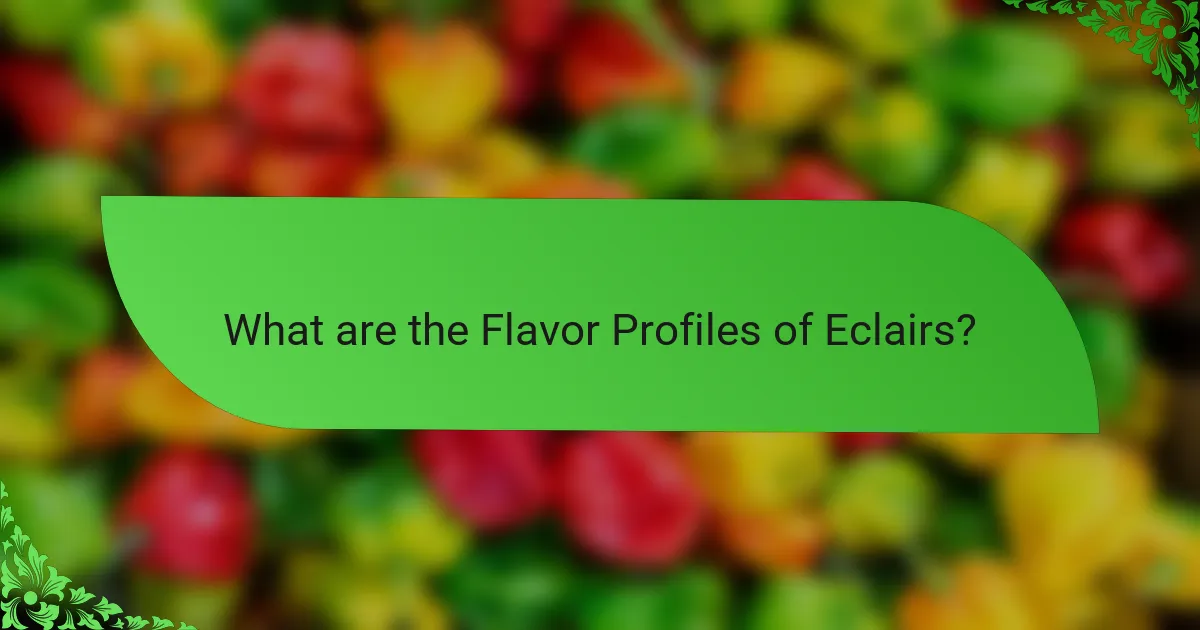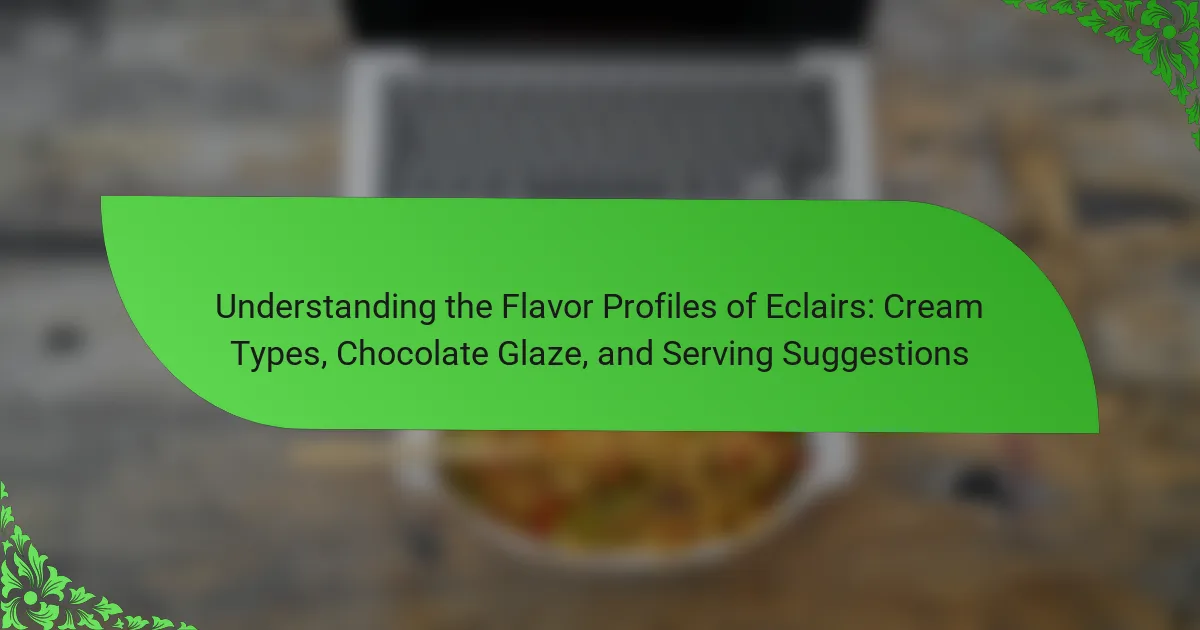Eclairs are a type of pastry characterized by their choux pastry shell filled with various creams and topped with a chocolate glaze. The article explores the different flavor profiles of eclairs, focusing on common fillings such as pastry cream, whipped cream, and chocolate cream, each contributing unique textures and tastes. The chocolate glaze, which can vary in sweetness and thickness, enhances both the visual appeal and flavor balance of the pastry. Additionally, the article provides serving suggestions that include pairing eclairs with fresh berries, whipped cream, or drizzles of chocolate or caramel sauce, aimed at maximizing the overall enjoyment of this delicacy.

What are the Flavor Profiles of Eclairs?
Eclairs have a variety of flavor profiles primarily influenced by their filling and glaze. Common fillings include pastry cream, which can be vanilla, chocolate, or coffee flavored. Each filling offers a distinct taste experience. The chocolate glaze adds a rich, sweet layer that complements the cream. Some eclairs feature fruit-flavored creams, like raspberry or lemon, providing a tart contrast. The texture of the choux pastry contributes to the overall flavor, being light and airy. Eclairs can also be enhanced with toppings like nuts or caramel, adding additional flavor dimensions. These combinations create a diverse range of flavors in eclairs, appealing to various palates.
How do different cream types influence the flavor of eclairs?
Different cream types significantly influence the flavor of eclairs. Pastry cream provides a rich, custard-like taste due to its egg and milk base. Whipped cream adds lightness and a sweet, airy quality. Chocolate cream introduces a deep, rich flavor that complements the pastry. Coffee cream infuses a bold, aromatic taste, enhancing the overall experience. The choice of cream alters sweetness and texture, impacting the overall flavor profile. For instance, a heavier cream can create a more decadent dessert, while a lighter cream results in a more delicate treat. Each cream type contributes unique attributes that define the eclair’s overall flavor.
What are the common cream types used in eclairs?
The common cream types used in eclairs are pastry cream, whipped cream, and chocolate cream. Pastry cream, also known as crème pâtissière, is a thick custard made from milk, sugar, eggs, and cornstarch. It provides a rich and creamy texture that complements the choux pastry. Whipped cream is light and airy, often sweetened and flavored, adding a delicate touch to the eclair. Chocolate cream, made by combining pastry cream with melted chocolate, offers a decadent flavor that enhances the overall dessert experience. Each cream type contributes uniquely to the flavor profile of the eclair, making it a versatile pastry choice.
How does each cream type affect the overall taste experience?
Different cream types significantly influence the overall taste experience of eclairs. For instance, pastry cream offers a rich, custardy flavor that enhances sweetness. Whipped cream provides a light, airy texture, contributing a subtle sweetness and creaminess. Chocolate ganache delivers a deep, intense chocolate flavor, enriching the dessert’s complexity. Coffee cream introduces a robust, aromatic note, balancing sweetness with bitterness. Each cream type interacts with the eclair shell, affecting texture and flavor perception. The combination of these creams creates a multi-dimensional taste profile. This diversity in cream types allows for a personalized flavor experience in eclairs.
What role does chocolate glaze play in the flavor profile of eclairs?
Chocolate glaze enhances the flavor profile of eclairs by adding richness and sweetness. This glaze complements the light, airy choux pastry and the creamy filling inside. The contrast between the sweet chocolate and the subtle flavors of the pastry creates a balanced taste experience. Additionally, the glaze provides a smooth texture that contrasts with the crisp exterior of the eclair. Its cocoa content contributes a slight bitterness, which offsets the overall sweetness. This balance is essential in creating a harmonious dessert. The visual appeal of the glossy glaze also enhances the overall experience, making eclairs more enticing.
What types of chocolate glazes are commonly used?
Common types of chocolate glazes include dark chocolate glaze, milk chocolate glaze, and white chocolate glaze. Dark chocolate glaze has a rich flavor and is often used for its intense taste. Milk chocolate glaze is sweeter and creamier, appealing to those who prefer a milder flavor. White chocolate glaze, although not technically chocolate, offers a sweet and buttery taste, providing a contrast to darker glazes. Each type of glaze can enhance the flavor profile of eclairs, making them more appealing to different palates.
How does the choice of chocolate glaze impact flavor and texture?
The choice of chocolate glaze significantly impacts both flavor and texture in eclairs. Different types of chocolate, such as dark, milk, or white chocolate, contribute distinct flavor profiles. Dark chocolate offers a rich, intense taste, while milk chocolate provides a sweeter, creamier flavor. White chocolate, lacking cocoa solids, delivers a sweet and buttery flavor.
Texture is also affected by the chocolate’s composition. A glossy, well-tempered dark chocolate glaze creates a firm, crisp shell. In contrast, a thicker, poorly tempered glaze may result in a softer, less desirable texture. The fat content in the chocolate influences mouthfeel; higher fat chocolate can lead to a smoother, creamier texture.
Additionally, the temperature at which the glaze is applied can alter the final texture. A warm glaze may soak into the eclair, affecting the overall consistency. In summary, the choice of chocolate glaze alters the flavor intensity, sweetness, and texture of the eclair, enhancing the overall eating experience.
How can serving suggestions enhance the enjoyment of eclairs?
Serving suggestions can significantly enhance the enjoyment of eclairs by providing complementary flavors and textures. For instance, pairing eclairs with fresh berries can add a tart contrast to the sweetness. Serving eclairs alongside whipped cream or ice cream can create a rich, creamy experience. Additionally, garnishing with chocolate shavings or nuts can introduce a crunchy element. These enhancements not only elevate the visual appeal but also enrich the overall tasting experience. Studies show that combining flavors can increase satisfaction, making thoughtful serving suggestions crucial for maximizing enjoyment.
What are the best pairings for eclairs in terms of flavors?
Chocolate eclairs pair well with coffee flavors. The bitterness of coffee complements the sweetness of chocolate. Vanilla eclairs pair nicely with fresh fruit flavors. Strawberries or raspberries enhance the vanilla cream. Matcha eclairs work well with citrus flavors. Lemon or orange adds a refreshing contrast. Caramel eclairs are best with nutty flavors. Hazelnut or almond enhances the richness of caramel. Each pairing enhances the overall tasting experience.
How should eclairs be presented for optimal taste experience?
Eclairs should be presented on a chilled plate to enhance their taste experience. The cool surface helps maintain the texture of the pastry and filling. They should be arranged neatly, with the chocolate glaze facing up for visual appeal. Garnishing with a dusting of powdered sugar adds an elegant touch. Serving eclairs alongside fresh fruit can provide a refreshing contrast in flavor. Pairing them with a light dessert sauce can elevate the overall experience. Using high-quality ingredients in both the pastry and filling ensures a richer taste. Presentation plays a crucial role in the enjoyment of eclairs, as it influences the first impression.

What are the key attributes of eclair cream types?
Eclair cream types primarily include pastry cream, whipped cream, and chocolate cream. Pastry cream is thick and custard-like, made from milk, sugar, eggs, and starch. It provides a rich, creamy texture and is often flavored with vanilla. Whipped cream is light and airy, created by whipping heavy cream with sugar. This type adds a fluffy texture and a sweet flavor. Chocolate cream combines pastry cream with chocolate, resulting in a rich and decadent filling. Each cream type contributes to the overall flavor profile of the eclair, enhancing its appeal.
What are the differences between pastry cream, whipped cream, and ganache?
Pastry cream, whipped cream, and ganache are distinct components used in desserts. Pastry cream is a thick custard made from milk, sugar, eggs, and starch. It is often flavored with vanilla and used as a filling in pastries. Whipped cream is a light, airy mixture made by whipping heavy cream, often sweetened and flavored. It serves as a topping or filling for various desserts. Ganache is a rich mixture of chocolate and cream, used for glazing, filling, or frosting. Each has a unique texture and flavor profile that contributes to the overall experience of desserts like éclairs.
How does pastry cream differ in flavor and texture from whipped cream?
Pastry cream has a rich, custard-like flavor, while whipped cream is light and sweet. The texture of pastry cream is thick and smooth due to its egg and starch content. Whipped cream is airy and fluffy because it is primarily made from whipped heavy cream. Pastry cream is often used as a filling in desserts like éclairs. Whipped cream serves as a topping or accompaniment for various sweets. The flavor of pastry cream can be enhanced with vanilla or chocolate, adding depth. In contrast, whipped cream’s sweetness can be adjusted with sugar. These differences make each cream suitable for specific culinary applications.
What unique attributes does ganache bring to eclairs?
Ganache brings a rich, velvety texture to eclairs. This unique attribute enhances the overall mouthfeel. The smooth consistency of ganache contrasts with the airy pastry of the eclair. Ganache also offers a deep chocolate flavor, which intensifies the dessert’s taste profile. Additionally, it can be flavored with various ingredients like vanilla or espresso, adding complexity. The glossy finish of ganache provides visual appeal, making eclairs more enticing. This combination of texture, flavor, and presentation sets ganache apart from other toppings.
How does the texture of cream affect the overall eclair experience?
The texture of cream significantly impacts the overall éclair experience. A smooth and velvety cream enhances the mouthfeel and richness of the éclair. This texture allows for a luxurious sensation, making each bite more enjoyable. Conversely, a grainy or overly thick cream can detract from the experience. It may create an unappealing contrast with the lightness of the choux pastry. The cream’s texture also influences how well it complements other elements, such as chocolate glaze. A well-textured cream balances sweetness and flavor, leading to a more harmonious dessert. Thus, the right cream texture is essential for an optimal éclair experience.
What are the textural characteristics of various cream types?
Cream types exhibit distinct textural characteristics. Whipped cream is light and airy, providing a fluffy texture. Heavy cream is rich and smooth, often used for sauces and soups. Pastry cream is thick and custard-like, ideal for filling eclairs. Sour cream has a creamy yet tangy texture, adding moisture to dishes. Cream cheese is dense and spreadable, perfect for frosting. Each cream type’s texture enhances its culinary application, contributing to the overall flavor and experience of dishes like eclairs.
How can texture influence the perception of flavor in eclairs?
Texture significantly influences the perception of flavor in eclairs. The contrast between the crisp outer shell and the creamy filling enhances flavor complexity. A light, airy texture in the choux pastry allows for a more pronounced flavor experience. Creamy fillings, like pastry cream, provide a smooth mouthfeel that complements sweetness. Research shows that texture can alter taste perception; for example, crunchy textures can enhance sweetness. Additionally, the way texture interacts with taste buds affects flavor release. A well-balanced texture can elevate the overall enjoyment of eclairs, making them more appealing.

What are the nuances of chocolate glaze in eclairs?
Chocolate glaze in eclairs serves as a rich, glossy finish. It enhances both the visual appeal and flavor profile of the pastry. The glaze typically consists of chocolate, cream, and sometimes butter. This combination creates a smooth texture that contrasts with the lightness of the choux pastry.
The sweetness of the glaze balances the richness of the cream filling. Dark chocolate is often used for a more intense flavor, while milk chocolate offers a sweeter taste. The thickness of the glaze can also vary, affecting how it coats the eclair.
A well-executed chocolate glaze should remain shiny and not crack upon cutting. It is essential to temper the chocolate properly to achieve the desired consistency. This technique ensures the glaze sets well and maintains its sheen.
What factors should be considered when choosing a chocolate glaze?
When choosing a chocolate glaze, consider the glaze’s viscosity. A thicker glaze provides a richer texture. The flavor intensity is also crucial; choose a glaze that complements the eclair filling. The type of chocolate used affects both taste and appearance. Dark chocolate glazes offer a more intense flavor, while milk chocolate glazes are sweeter. Additionally, consider the glaze’s shine; a glossy finish enhances visual appeal. The setting time is important; some glazes harden quickly, while others remain softer. Lastly, check for any dietary restrictions, such as dairy or gluten content. These factors ensure the glaze enhances the overall eclair experience.
How does the cocoa content in chocolate affect flavor intensity?
Higher cocoa content in chocolate increases flavor intensity. As cocoa percentage rises, the chocolate becomes more bitter and complex. This bitterness enhances the overall flavor profile. Chocolates with 70% cocoa or more exhibit pronounced cocoa flavors. In contrast, lower cocoa chocolates tend to be sweeter and less intense. The presence of cocoa solids contributes to rich, deep flavors. Additionally, higher cocoa content often means fewer added sugars. This balance creates a more robust taste experience. Studies show that consumers often prefer darker chocolates for their intense flavors.
What are the differences between dark, milk, and white chocolate glazes?
Dark chocolate glaze contains a higher percentage of cocoa solids and less sugar. It has a rich, intense flavor profile. This type of glaze is often used for its deep taste and slightly bitter notes. Milk chocolate glaze includes milk solids and sugar, resulting in a creamier, sweeter flavor. It is popular for its smooth texture and milder taste. White chocolate glaze lacks cocoa solids entirely and is made from cocoa butter, sugar, and milk solids. This results in a sweet, buttery flavor with a creamy consistency. Each type of glaze serves different culinary purposes, enhancing the overall flavor of eclairs.
How does the temperature of the glaze impact the eclair’s flavor?
The temperature of the glaze significantly impacts the eclair’s flavor. A warm glaze can enhance the sweetness and richness of the chocolate. It allows the flavors to meld better with the pastry. Conversely, a cold glaze may create a more pronounced contrast. This can lead to a firmer texture and a less integrated taste experience. The ideal temperature for a chocolate glaze is around 90°F to 100°F. This range ensures a glossy finish while accentuating the chocolate’s flavor. Studies show that temperature influences sensory perception, affecting sweetness and aroma release. Thus, the glaze’s temperature directly affects the overall flavor profile of the eclair.
What are the effects of warm versus cold chocolate glaze on taste?
Warm chocolate glaze enhances sweetness and provides a smoother texture, making it more appealing. Cold chocolate glaze tends to be firmer and can create a contrasting crunch. The temperature affects the release of flavors. Warm glaze releases volatile compounds, intensifying the chocolate taste. Cold glaze may mask some flavors due to its solid state. Sensory evaluations show that warmth can enhance the overall tasting experience. Research indicates that temperature influences flavor perception significantly.
How can temperature variations enhance or detract from the flavor profile?
Temperature variations can significantly enhance or detract from the flavor profile of eclairs. Serving eclairs at a slightly warmer temperature can intensify the sweetness and richness of the cream filling. Cold temperatures can mute flavors, making the eclair taste less vibrant. For example, chocolate glaze is more aromatic when slightly warmed, releasing more cocoa notes. Conversely, if eclairs are too warm, the cream may become overly soft, affecting texture and mouthfeel. Studies show that optimal serving temperatures for desserts can elevate flavor perception by up to 20%. Therefore, maintaining appropriate temperature is crucial for achieving the desired flavor experience in eclairs.

What are effective serving suggestions for eclairs?
Eclairs are best served chilled or at room temperature. Pair eclairs with a dusting of powdered sugar for added sweetness. Serve them alongside fresh berries to enhance their flavor. A dollop of whipped cream can complement the cream filling. Drizzling chocolate or caramel sauce adds a rich touch. Present eclairs on a decorative platter for visual appeal. Consider pairing them with coffee or tea for a delightful experience. These serving suggestions enhance the enjoyment of eclairs.
What are some creative ways to serve eclairs to enhance flavor?
Serve eclairs with flavored creams to enhance their taste. Consider using matcha or raspberry cream for a unique twist. Pair eclairs with complementary sauces like salted caramel or berry coulis. Drizzle chocolate ganache over eclairs for added richness. Incorporate fresh fruits, such as strawberries or citrus segments, as toppings. Serve eclairs alongside flavored whipped cream for a light touch. Experiment with different glazes, like coffee or lemon, to elevate flavor. These methods create a diverse tasting experience that excites the palate.
How do garnishes and accompaniments affect the overall flavor experience?
Garnishes and accompaniments enhance the overall flavor experience by adding contrasting or complementary tastes and textures. For example, fresh fruits can introduce acidity and sweetness that balance the richness of eclairs. Herbs or spices may add depth and complexity to the flavor profile. The visual appeal of garnishes can also influence perception, making flavors seem more vibrant. Research indicates that presentation affects taste perception, as noted in “The Influence of Food Presentation on Taste Perception” by Spence et al. (2016). Therefore, the choice of garnishes and accompaniments is crucial in creating a well-rounded flavor experience.
What are some traditional serving methods for eclairs?
Eclairs are traditionally served in a few specific ways. They are often presented on a decorative platter. This enhances their visual appeal. Eclairs can be garnished with a dusting of powdered sugar. This adds a touch of sweetness and elegance. Additionally, they may be accompanied by whipped cream or fresh fruit. This complements the flavors of the eclairs. Some serve eclairs with coffee or tea. This pairing is popular in many cultures. These serving methods highlight the eclairs’ rich textures and flavors.
What tips can enhance the enjoyment of eclairs?
To enhance the enjoyment of eclairs, consider pairing them with complementary beverages. Coffee or espresso balances the sweetness of the eclair. Herbal teas can also provide a refreshing contrast. Additionally, serving eclairs chilled can elevate their texture and flavor. Chilling enhances the creaminess of the filling. Experimenting with different cream types, like vanilla, chocolate, or coffee, can diversify the experience. Using high-quality chocolate for glazing adds richness. Finally, garnishing with fresh fruits or nuts can introduce new flavors and textures. These tips can significantly improve the overall enjoyment of eclairs.
How can one choose the perfect beverage pairing for eclairs?
To choose the perfect beverage pairing for eclairs, consider the flavor profiles of the eclairs. Eclairs typically feature creamy fillings and sweet glazes. A classic pairing is coffee, which complements the richness of the cream. The bitterness of coffee balances the sweetness of the eclair. Additionally, a light tea, such as Earl Grey, can enhance the dessert’s flavors. The citrus notes in Earl Grey contrast nicely with chocolate glazes. Sparkling water is another option, as it refreshes the palate between bites. Each beverage choice should enhance the overall tasting experience without overpowering the eclair’s delicate flavors.
What are the best practices for storing eclairs to maintain flavor?
Store eclairs in an airtight container to maintain their flavor. This prevents exposure to air, which can cause them to dry out. Keep the container in a cool, dry place, away from direct sunlight. Refrigeration is also an option, especially if they contain cream, but may alter the texture. Consume eclairs within 1-2 days for optimal flavor. If freezing, wrap them tightly in plastic wrap and place them in a freezer-safe container. Thaw them in the refrigerator before serving to retain flavor and texture.
The main entity of this article is eclairs, a popular pastry known for their diverse flavor profiles influenced by cream types and chocolate glazes. The article provides an in-depth analysis of various cream types, including pastry cream, whipped cream, and chocolate cream, detailing their impact on flavor and texture. It also examines the role of chocolate glaze, including different types and their effects on the overall taste experience. Additionally, the article offers serving suggestions and best practices to enhance the enjoyment of eclairs, ensuring a comprehensive understanding of this beloved dessert.
